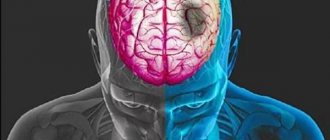Dementia is a serious disease that causes irreversible consequences. In 60-70% of cases it is a consequence of Alzheimer's disease. Those suffering from dementia lose memory, the ability to perform everyday activities, communication skills, and logical thinking. Women over 65 years of age are most susceptible to the disease. However, with a combination of unfavorable factors (alcoholism, the presence of chronic cardiovascular pathologies), men also suffer from dementia.
Since the disorder is progressive, it is especially important to identify it and begin treatment as early as possible. In most cases, timely preventive measures and a friendly atmosphere can reduce stress in elderly patients and increase the chances of reversing most of the negative consequences.
Identifying the disorder in its early stages is not easy, but it is possible. To do this, you need to know the specific signs inherent in each stage of dementia. By comparing them with each other, you can take timely measures to prevent its further progression and give your loved one the opportunity to spend old age maintaining mental health.
How to recognize dementia?
There are several types of the disorder, which differ from each other in symptoms:
- Vascular.
- Atrophic.
- Mixed.
Associated deviations may appear in different sequences. Therefore, to determine effective treatment, it is especially important to determine the specific type of this disease that your loved one is developing.
Vascular dementia
This type of disease is rapidly progressive. Its first signs will be noticeable within the first 3 months after its appearance. These include:
- inability to concentrate on some task or thought, inattention, absent-mindedness;
- loss of short-term memories;
- reluctance to communicate with others;
- anxiety and irritability, suspiciousness;
- mental degradation;
- loss of interest in life;
- drowsiness during the day and insomnia at night.
As the disease develops, it manifests itself in the following symptoms:
- memory loss, loss of long-term memories;
- distorted perception of reality (complaints about KGB surveillance are one of the most obvious signs of dementia);
- change in personal qualities (the person was kind and sympathetic, but sharply changed his attitude towards others, becoming embittered and dissatisfied);
- inability to self-care and loss of personal hygiene skills;
- motor dysfunction.
Atrophic dementia
This type of disorder is more secretive than the vascular one. Symptoms are not expressed clearly, as they are often confused with age-related changes in the body of an elderly person. Because of this, atrophic dementia can develop within 5-8 years. Among the primary signs of the disorder are the following:
- loss of short-term memory;
- confidence in one’s rightness, even if the patient’s thoughts and actions are illogical;
- inability to accept and remember new information.
As the pathology develops, it manifests itself in more visible signs:
- memory impairment;
- failure to perceive a logical chain, inability to connect clearly comparable facts;
- impaired perception of reality (hallucinations, persecution mania, etc.);
- inability to self-care and maintain hygiene skills;
- loss of the ability to express your needs;
- lack of self-control (undressing in public places, unjustified aggression towards others).
Mixed dementia
The disease develops against the background of a combination of vascular lesions of the brain and primary degenerative disorders (usually Alzheimer's disease). It includes symptoms of two types of dementia and occurs in a more complex form.
Note! Some diseases may be mistaken for dementia due to the similarity of some individual symptoms:
- depression;
- thyroid diseases;
- lack of vitamins (for example, group B, vitamin B12);
- infections;
- brain tumor.
Eliminating the signs of these disorders can significantly improve the patient's condition. However, it is important to separate them from real dementia - this can only be done by a qualified specialist.
In the absence of timely treatment, the disease can develop into a severe pathology, and it will be impossible to reduce its impact on the patient. Therefore, you should pay special attention to the health and condition of elderly relatives. This approach will allow you to maintain a high quality of life for your loved ones and provide them with a dignified old age.
Risk factors for developing the disease
One of the most important risk factors for developing a disease such as dementia is advanced age, which is why the adjective to the word dementia is almost always the term “senile.” On the other hand, the statement “old age equals dementia” is fundamentally incorrect; this disease is not an inevitable consequence of aging.
As a result of numerous studies, it was found that:
- regular exercise;
- to give up smoking;
- body weight control;
- proper balanced nutrition;
- control blood pressure, cholesterol and blood sugar levels
reduce the risk of developing dementia. Conversely, if an older person does not control the factors listed above, the risk of developing dementia increases.
Other risk factors are low level of education, persistent depression, and social isolation. In the same series we can name such cognitive functions as thinking, imagination, attention, perception, that is, the constant mental activity of an elderly person.
Older women are more prone to such a serious age-related disease as Alzheimer's disease, while men, on the contrary, are more likely to develop dementia.
Genetic predisposition plays a significant role in the development of this disease. If someone from the family, especially in the so-called first generation (parents-children), suffered from Alzheimer's disease or dementia, then the likelihood of developing the same disease in the heirs almost doubles.
A test that can help detect dementia
If, even after detecting more than half of the accompanying signs of the disease, you doubt that your loved one is developing a serious pathology, ask him to complete a simple task. The MiniCog test makes it possible to detect dementia in its early stages with a high degree of probability.
- Ask your loved one to remember 3 words you suggested. They should not be related to each other in meaning - for example, a tablecloth, a dump truck, a feather.
- Ask the person to draw a round clock face from memory and indicate all the numbers and hands on it. At the same time, set a specific time - for example, 4:30.
- After he completes the second task, ask him what 3 words you asked him to remember.
A healthy person can easily complete the task. People with dementia make mistakes early in the development of the disorder. Thus, numbers are often arranged in a mirror manner, unnecessary numbers are added (after 12 they put 13, 14, etc.). That is, problems are already noticeable, and they can be noticed in a timely manner.
Possible options for depicting a watch dial by patients with dementia
If your relative did poorly on the test, you should not delay contacting specialists, for example, for consultation at a boarding house for elderly people with dementia. The sooner steps are taken to control the progression of the disorder, the greater the opportunity for successful treatment.
It is worth keeping in mind that a definitive diagnosis cannot be made based on the test your loved one has taken. Such exercises can prompt you to consult a specialist to identify the disease. Only a doctor can make a diagnosis, assess the severity of the pathology and prescribe effective treatment.
Main symptoms of the disease
We have already said that the first symptoms of the disease do not cause concern: it all starts with mild forgetfulness, which is attributed to old age. But then the disease progresses and other symptoms of dementia appear:
- Fine motor skills of the hands deteriorate, a slight tremor begins, which gradually increases, capturing more and more new parts of the body.
- Hygiene problems. The patient may forget to brush his teeth, then skips water procedures, forgets to put on mandatory clothing (for example, a man can go outside without trousers, and a woman without a skirt).
- The train of thought is disrupted, the person loses the thread of the conversation, subsequently forgets even the names of the most common objects, for example, he will look at a fork and painfully remember the name of this object.
- Psychomotor skills deteriorate.
If the relatives of an elderly person closely monitor his condition, they will not miss the onset of dementia. It is important to remember that once symptoms appear, they will not disappear; they will only worsen and multiply like a snowball. That is why it is important not to miss the very beginning of the disease and have time to take measures in order to achieve, even if not a complete cure (this is impossible), then at least delay the onset of serious consequences.
Disease statistics
World statistics provide disappointing information: the number of people suffering from dementia is steadily growing. In 2009, the number of people with dementia was estimated to be about 35 million, and the number was projected to be 115 million by 2050. But the forecast has now been increased by 15 million. That is, the rate of increase in the incidence of dementia is steadily increasing, this is an alarming sign.
Currently, the morbidity statistics in Russia are not encouraging either. We are in seventh place in the world in terms of incidence of this serious disease. According to the most optimistic estimates, about two million elderly people in Russia are currently diagnosed with dementia, and this figure is growing.
“The future belongs to preventive medicine”
The development of medical science and the expansion of knowledge about our body, healthy or sick, leads to the fact that medicine penetrates more and more into everyday life. We can cautiously call this process the medicalization of everyday life. An illustrative example of the medicalization of everyday life was the coronavirus epidemic [3], which began at the end of 2021 and continues to this day. Medical procedures have begun to permeate our daily rituals, and conversations about the coronavirus vaccine and treatment have become as commonplace as sharing recipes or discussing politics. Medicine penetrates deeper into our lives than we think. It is not limited to the clinic door and the hospital emergency room. 2021 has shown us how much medical problems can change in our lives - private and public (Fig. 2).
Figure 2. In 2021, we all find ourselves in a new world where there is a coronavirus pandemic. Many of us were very active in discussing a variety of medical issues, such as the need to wear masks.
Myths about Masks and Other Coronavirus Facial Coverings
Historically, doctors dealt with sick people and diseases. The doctor rarely visited a healthy person or vice versa. Contact with a patient occurred when the patient developed symptoms or was concerned about their own health. This almost inevitable negative emotional context of communication with a doctor is an important feature of medical communication. Over time, medical knowledge has significantly changed the world around us, and medicine no longer serves as a tool solely for survival. People began to develop a demand for maintaining health, and not for restoring it. Over time, medicine for the sick began to be supplemented by medicine for the healthy. Traditional medical education focuses on treating disease and restoring health, rather than preserving it. The preventive component in professional medical practice is poorly developed. I think that people do not always understand why they need to go to a doctor for information about maintaining health, because he deals with sick people, not healthy ones.
The result of the discrepancy between the activities of doctors and the demands of people was the appearance in this field of people without special medical education. Bloggers and coaches tell people about a healthy lifestyle, based on publicly available scientific information. It cannot be said that all of them are telling lies or causing harm, but the level of expertise and responsibility for their words among this group of people is usually low. Why should people get a medical education when there is PubMed, Google Scholar, Instagram and TikTok? Although, judging by the quality of the content, for many authors, reading scientific articles and analyzing them for their own audience still remains a prohibitively difficult task.
Of course, there is nothing wrong with people’s interest in maintaining their health. The state, with a reasonable approach, should also have an interest in preserving the health of its citizens. A common theme in discussions of the impact of any disease in scientific research is the economic loss from disability and mortality associated with this disease. Caring for people's health is a long-term investment by the state or a private company, as well as a competitive advantage over other players in this field. This is where the importance of preventive medicine lies. Some diseases are easier and cheaper to prevent than to treat. This is also true for mental disorders.
About types of prevention
Before we get acquainted with the features of prevention of mental disorders, we should better understand what prevention is. Prevention is a set of measures aimed at preventing injuries and diseases. A good example of a preventive measure would be vaccinations - medical interventions that annually save hundreds and thousands of lives of people around the world (read the special project on vaccination on Biomolecule). It should be understood that preventive measures can reduce the risk of a negative event, but do not completely eliminate it.
There are usually two types of prevention:
- Primary prevention is action directed against the occurrence and exposure of a person to risk factors for diseases and injuries. In the case of primary prevention, we try not to create opportunities for harm to health. Primary prevention measures are varied and are implemented at the personal level and at the level of large communities. Hand washing, legal speed limits on roads, safe sex practices and food hygiene are all primary prevention measures.
- Secondary prevention prevents the transition of the asymptomatic course of the disease to clinical manifestations. Secondary prevention includes regular medical supervision of patients from risk groups and changes in lifestyle for representatives of these groups. If we detect a person has high cholesterol levels, but there are no symptoms of coronary heart disease or other atherosclerotic vascular disease, then interventions at this stage will be secondary prevention. This may include diet, increased physical activity and/or medication. As with primary prevention, secondary prevention is largely a matter of changing the lifestyle of a person at risk of developing the disease. Preventing repeated deterioration of the patient's condition with the help of drug therapy can also be classified as secondary prevention.
The famous statement of Nikolai Ivanovich Pirogov, used as the title for this chapter, reveals the direction in the future development of medicine. We have been actively researching mental disorders and other illnesses. Much, although not everything, became clear to us about our illnesses. The time has come to put this knowledge into practical use.
Preventive measures for healthy people usually involve lifestyle changes. They focus on human behavior. These measures help prevent negative events or instill in people the habit of protective actions. Wearing medical masks was and remains an unusual ritual for us, but for China it is a common measure that did not have to be adapted to during the epidemic of the new coronavirus. Preventive medicine is closely related to public health. Sometimes the norms of preventive medicine require enshrinement at the legislative level, and this is a fair decision. We cannot allow people who are carriers of intestinal infections into food production to prevent the emergence of another Typhoid Mary.
An example of a preventative mental health intervention that focuses on behavior would be limiting access to highly toxic pesticides in Asia. Suicide in rural areas in Asia is a serious social and health problem [4]. The number of deaths in this region of the planet caused by self-poisoning with pesticides amounts to thousands of people per year. One of the reasons is the easy availability of highly toxic pesticides to farmers. As researchers of this problem note, farmer suicides using pesticides are usually impulsive. This means that limiting access to pesticides could theoretically reduce the number of pesticide victims. A ban on the storage and use of highly toxic pesticides has reduced mortality from this cause in agricultural areas of Asia. In India, for example, special centralized storage facilities for pesticides were installed, which made it difficult for those who might use them as a means of self-poisoning to quickly access them.
Disease prevention
Of course, it is easier to prevent any disease than to treat it later, dementia is no exception. Measures to prevent dementia are:
- Controlling blood sugar and cholesterol levels, monitoring blood pressure and preventing its serious increase. Any serious interruptions in the functioning of the body can become a trigger for this serious disease.
- Complete cessation of bad habits. Smoking and alcohol addiction can cause a stroke or heart attack, which, in turn, can trigger dementia.
- Regular feasible physical exercise and walks in the fresh air. They stimulate blood flow to all organs, which not only improves overall well-being, but also improves mood.
- Balanced healthy diet. It is advisable to give preference to foods such as vegetables, fruits, fish, cereals, nuts, while simultaneously eliminating (or seriously reducing) the consumption of smoked meats, marinades, and other not very healthy foods.
- Communication. It is important to maintain the same social circle and not withdraw into yourself. Self-sufficiency is good if it is in moderation.
Disability group
The appendix to the rules on recognizing a person as disabled includes clause No. 5, where dementia (severe, profound and severe mental retardation) is a disease for which lifelong disability is given no later than two years after the initial determination of disability. The first disability group is issued under certain conditions:
- health problems of the patient with a pronounced degree (IV) of impaired body functions;
- third degree of severity of restrictions on the patient’s categories of life activity: ability to care for oneself;
- mobility abilities;
- communication skills;
- ability to work;
- ability to orient and control behavior;
- learning abilities.
Dementia, multiple sclerosis, Alzheimer's disease and other pathological conditions cause disability. MSE can be carried out not only in the presence of the patient, but also in absentia by decision of the bureau. The examination can be carried out in an inpatient department of a hospital or at home, if the patient’s health condition does not allow it and a certificate from a medical institution is available. In some cases, additional examination is prescribed. When the experts have received all the data, the commission makes a decision on recognition of disability or refuses to recognize disability. When a person is recognized as disabled, he is issued the following documents:
- certificate of disability group;
- a certificate of temporary incapacity for work (if a person works and is on sick leave, a note is made about the decision of the ITU);
- individual rehabilitation program.
To apply for benefits, an extract is required, which is drawn up from the patient’s examination report. Based on the extract, a pension for a disabled person is calculated.
Questions and answers
When does alcohol-related dementia begin to develop?
Dementia due to the abuse of alcoholic beverages develops under conditions of prolonged use of alcohol - 10-15 years. The condition is aggravated by vascular pathology and liver diseases.
If a person periodically forgets the names of his relatives in old age, is this developing dementia or simply senile forgetfulness?
This condition is typical for older people. If there are no additional signs of dementia (decreased intelligence and disturbances in the emotional-volitional sphere), there is no need to worry. It is advisable to consult a family doctor or general practitioner.
Diagnosis of the disease
Suspicion of dementia is a good reason to see a doctor. This pathology is dealt with by a therapist, a neuropsychologist, a neuropathologist, a psychiatrist and a specialist who deals with diseases of the elderly. The diagnosis is made after interviewing the patient’s relatives and the patient himself. Important information is:
- age;
- characteristic signs;
- frequency of symptoms;
- time of onset of pathology.
A comprehensive neurological examination using modern equipment allows us to determine where the foci of pathology are located. The diagnosis is finally made only when symptoms are observed for six months and intensify over time.
A number of psychological tests are carried out to assess cognitive function. They make it clear at what level of consciousness the patient is. During testing the following is established:
- degree of orientation in space;
- features of attention;
- volume of short-term and long-term memory;
- thought processes (abstract, logical);
- the presence or absence of hallucinations, illusions;
- ability to think critically and plan.











